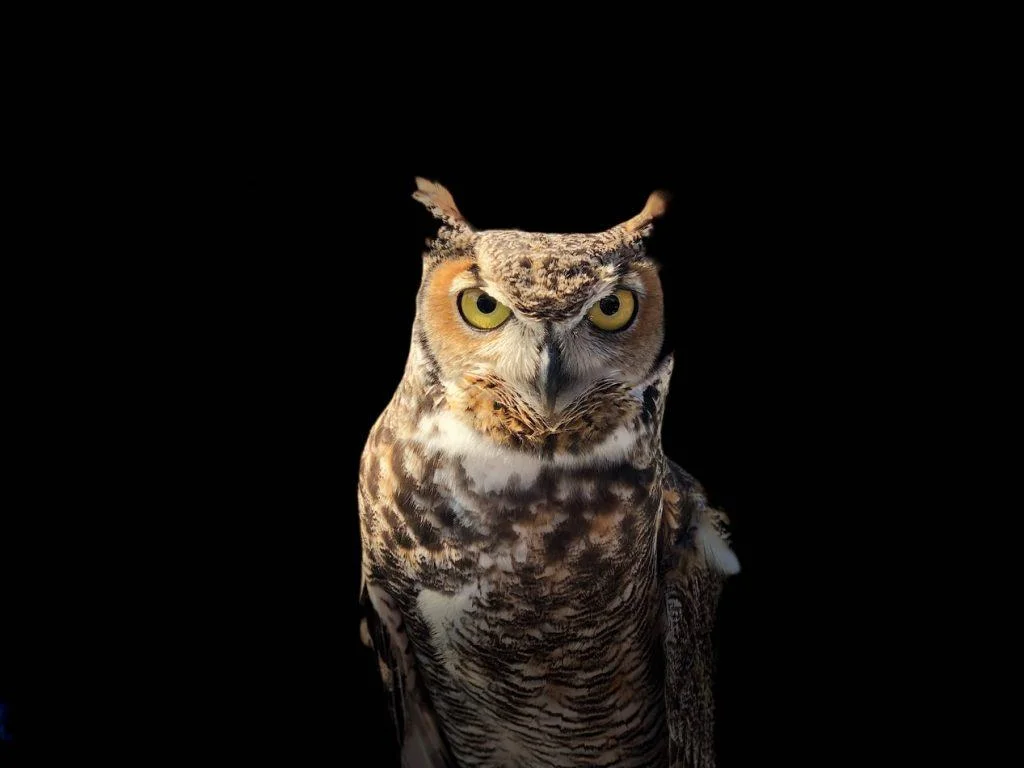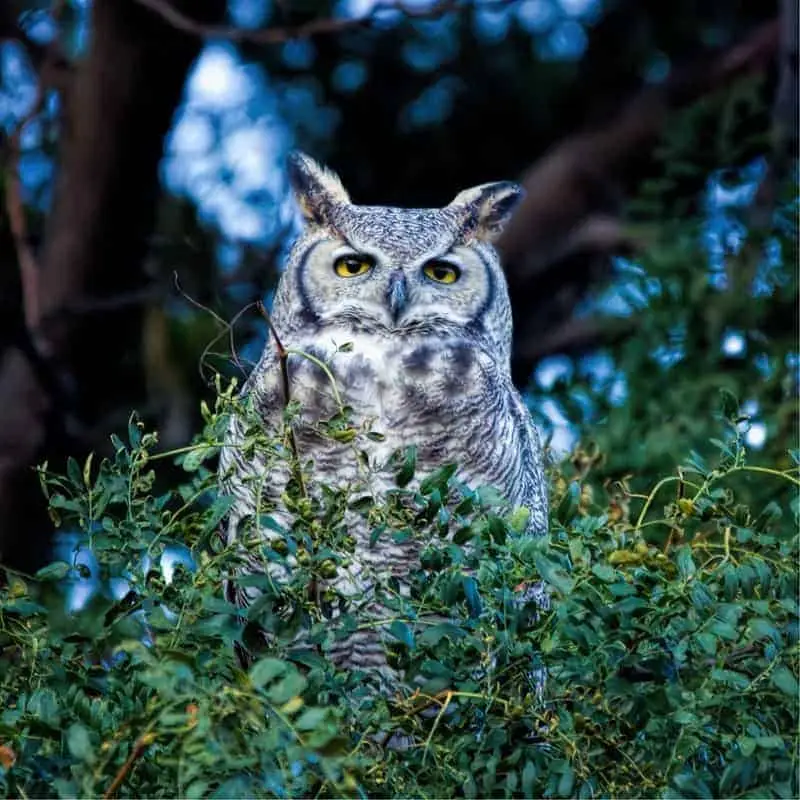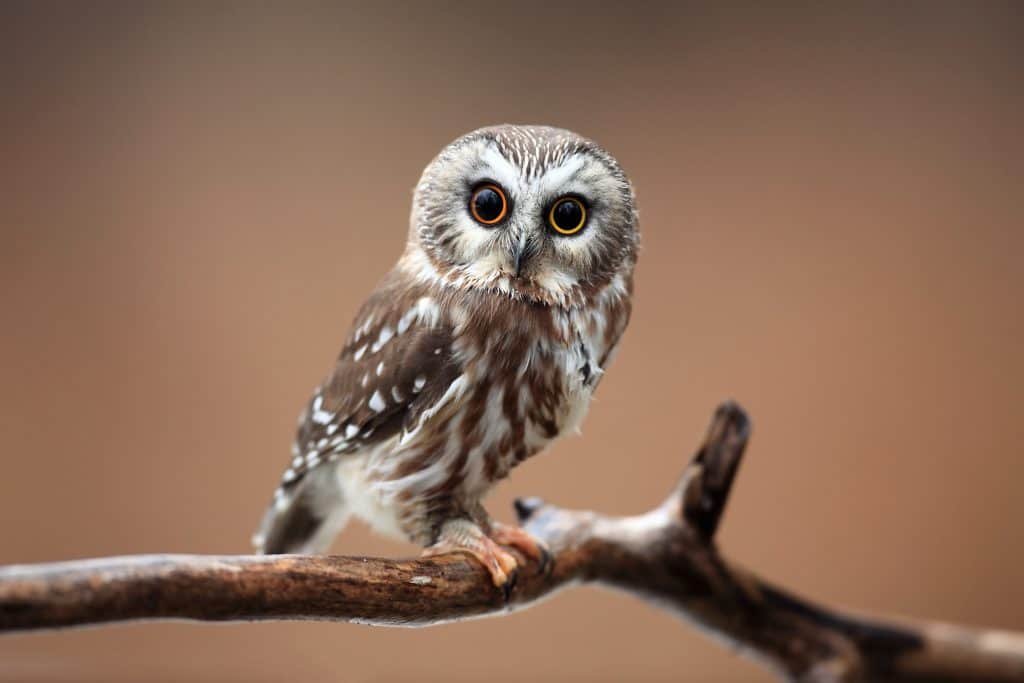
Want to learn more? This National Geographic Book on Owls is a great read!
The Eastern Screech-Owl has been the most commonly sighted owl in New Jersey and there have been reports of a Northern Hawk Owl, but the limited data suggests that it may have been a misidentification.
New Jersey is a north eastern state which has a moderate climate. This means that the state has warm summers and cold winters.
There are a total of 50 different state parks across New Jersey and there are 4 different national parks.
These parks are Morristown National Historical Park, the Sandy hook Unit of Gateway National Recreation Area, the Delaware Water Gap National Recreation Area and the Great Falls of the Passaic River.
Now that we’ve looked at the parks in where you may be able to see some of these owls, let’s have a look at the individual owl species that you can see in New Jersey in more detail.
Want to attract Owls to your yard? Take a look at our article!
What Owls can be seen in New Jersey?
Table of Contents
1. Barn Owl

Wingspan
107 to 110 cm
Weight
430 – 620 g
Life Expectancy
Up to 4 years
Diet
Voles, Shrews & Mice
The Barn Owl can appear to be completely white in certain lights, but they are actually covered in pale cream and buff feathers.
These medium sized owls have a large range that spans across 48 of the states in America. These owls are most commonly found in areas of large open grasslands.
There have been reports of males mating with several females but these owls are usually monogamous and their breeding pairs are long term. Barn Owls are not territorial when it comes to their hunting sites, but, they are very territorial when it comes to areas surrounding their nests.
These owls are permanent residents in New Jersey and therefore can be seen throughout the year. They can also be seen in all regions of the state with the most common sightings being recorded in the southern areas of New Jersey.
2. Eastern Screech Owl

Wingspan
46 to 61 cm
Weight
160 g
Life Expectancy
14 years
Diet
Rats, Squirrels, Rabbits & Skunks
The Eastern Screech-owl has very impressive feathers that help it to camouflage well against the bark of trees, these feathers come in various shades of grey.
You can see this medium sized owl in any area of woodland with a dense enough number of trees to provide protection for the bird.
These owls cannot nest successfully in areas of insufficient cover, so they greatly benefit from the addition of manmade birdboxes. Like lots of owl species, these birds are most active during the night-time and this is when they hunt.
These birds form breeding pairs that are stable and help raise the young together but, whilst they are most monogamous, some males will mate with two females rather than one.
Their young and stay with them for the first ten weeks of their life before they begin to break off on their own and both the male and female will help look after the fledglings. These owls will only have one brood per breeding season, and this consists of two to six individual eggs.
As suggested by their name, this owl has a range that spans across the eastern states of America.
They can be seen in all areas of New Jersey and are permanent residents of the state, this means that they can be spotted in New Jersey throughout the year.
Sightings of this owl are fairly evenly distributed with some higher areas of sightings being in the eastern half of the state.
3. Great Horned Owl

Wingspan
~140cm
Weight
1.4 kg
Life Expectancy
28 years old
Diet
Squirrels, Rabbits & Skunks
These large owls get their names because they look like horns on top of their heads thanks to their long-pointed ear tufts.
These owls have a stocky body and thick feathers that are greyish brown shades. These birds form breeding pairs have been known to stay with each other outside of the breeding season.
They remain monogamous to their partner and their breeding pairs are long-term. Both males and females are very territorial birds and have a series of hoots that they will use to defend their territory.
In fact, these birds are so territorial that they have at times been known to kill other individuals of their own species that do not back off after aggressive displays.
They are often harassed by other species of birds that will try to get them to abandon the area and their eggs, some of these birds include crows and even smaller songbirds.
These owls have one of the largest ranges across America of any owl species. Because of this they can be seen in the state of New Jersey throughout the whole year and they can also be seen in throughout all regions.
Most of the sightings of this owl have been in the far southern regions of the state.
4. Northern Saw-whet Owl

Wingspan
40 - 60 cm
Weight
100 g
Life Expectancy
7 years
Diet
Small birds, young squirrels, voles & shrews
The Northern Saw-whet Owl is small in size for an owl and their tiny bodies are covered in a variety of brown feathers.
These small owls roost throughout the day and will make their nests in a variety of forest areas. Males will sometimes mate with several different females during the breeding season, but these birds are primarily monogamous and will form breeding pairs.
These breeding pairs will often stay together outside of the breeding season to help each other defend their territory, however, they often form new breeding pairs in subsequent mating seasons.
Their breeding season is from the end of January to the beginning of May which is when you will hear their distinct too-too-too mating call. A male will try to court any female that enters his territory and to do this he will circle around her in flight 20 times before moving down to her and gifting her with a prey item.
They prey item is most commonly a rodent such as a lemming or a mouse. These birds are often preyed upon by larger species of owls so have to be careful when they are hunting.
You can see these owls throughout all the regions of New Jersey, but they are not permanent residents. They can only be seen outside of their breeding seasons and most commonly in winter.
Most of the recorded sightings of this bird have been to the north of the state whilst the lowest number of recorded sightings have ben in the central regions of New Jersey.
5. Short-Eared Owl

Wingspan
85 to 110 cm
Weight
206–475 g
Life Expectancy
4-12 years
Diet
Voles, Mice, Squirrels
Short-eared owls are a medium sized species of owl that are covered in brown and white spotted feathers.
Whilst these birds have barely visible ear tufts, they are present on the side of their head, hence their name. These owls prefer to stay in areas of open country and low vegetation and will hunt during both the day and the night.
Short-eared owls form loose colonies and are monogamous maters during the breeding season, however it is not confirmed as to whether these Short-eared Owls mate for life.
Breeding pairs only tend to roost in trees during the winter months especially when it is snowy, when it is not winter, they are happy to roost on the ground.
Whilst females spend their time incubating the eggs the males will also help defend their territory with a series of harsh calls.
Whilst these owls can be seen in all regions of New Jersey, they can only be seen in the state outside of their breeding seasons.
Sightings of this owl all seem to have been recorded across the borders of the state with very few sightings occurring in the central regions of New Jersey.
6. Snowy Owl

Wingspan
150 cm
Weight
2 kg
Life Expectancy
10 years
Diet
Birds, Rabbits, Fish & Rodents
The Snowy Owl is a species of owl that is covered in thick white feathers and they are medium in size.
Some of these feathers have unique grey markings on their tips which are visible at close range.
Males exhibit a unique flight display when courting a female, they will grasp some prey in their talons before performing a very large dive with their wings in a v shape.
There is still debate as to whether these birds are monogamous and form long term breeding pairs. These birds are incredibly defensive of their territories and are not afraid to attack their own species and others if necessary.
There have even been a reported incidents of Snowy Owls dive bombing humans that have strayed too close to their nesting areas. Snowy Owls like wide open spaces with a minimal number of trees, they are most commonly found in tundra habitats and across plains.
They will also perch of high man-made items such as telephone poles during the winter months when they move into more southern states. This is so that they can observe prey more clearly.
Snowy owls usually stay in arctic areas like Canada so are rare visitors to New Jersey. They can only be seen in the state during the winter months and the recorded sightings of this bird all seem to be along the eastern coast of the state.
There have been very few sightings to the south west of the state.
7. Long Eared Owl

Wingspan
90 to 100cm
Weight
250 g
Life Expectancy
4 years
Diet
Small mammals, mice, rats & rabbits
The Long-Eared Owl is known for its long and prominent feathered ears, which is not surprising considering its name.
They have orange faces and their bodies are covered with black and brown feathers. These owls like to roost in loose colonies and make their nests in dense areas of forests.
Outside of the breeding seasons, these colonies can reach up to 100 individuals. During the breeding season these colonies will nest near each other, but they will not roost together, and the numbers will also be lowered.
These birds only mate with one individual during the breeding season, although it is not known as to whether they form long term breeding pairs.
Males will perform a series of complex, zigzag flights whilst producing a mating call in an attempt to court a female.
This owl has a wide range across the state of New Jersey, but they can only be seen outside of their breeding season. they have been seen in areas all across the state, but the most common area of sightings has been to the far northern regions of the state.
8. Barred Owl

Wingspan
96-125 cm
Weight
468-1,150 g
Life Expectancy
10-23 years
Diet
Small mammals
This owl got its name because of the barred patterns on its wings and back formed by its white and brown feathers.
You are most likely to see these owls close to bodies of water in dense areas of mixed forests. They are territorial throughout the year but become more aggressive during their breeding seasons.
These birds are thought to form breeding pairs that mate for life and are thought to be monogamous. Some species of smaller birds which are usually prey for Barred Owls, may band up and form mob like attacks against these owls.
If this occurs the Barred Owls will screech and perform aggressive displays in an attempt to get them to leave.
These birds can be seen in all areas of New Jersey and they are permanent residents meaning you can see them in the state throughout the year.
They have most commonly been reported in the central regions of the state and they are most active during mating seasons.

More Articles.

How to Attract Bees to Your Yard?
Bees play a vital role in the environment, helping to spread the pollen of flowers

Best Camera For Bird Watching 2020
Article Summary: Best Budget Camera: Nikon D500 DX-Format Digital SLR Best Mid-tier Camera: Canon EOS

How to attract dragonflies to your yard?
Dragonflies are somewhat startling in appearance with their long bodies, wide wings, and rather large

About Us
We are avid bird-watchers who recently retired, allowing us more time to travel the world. Fortunately, we have managed to visit numerous countries around Europe, Asia, and America. Watching and photographing birds has been a passion for many years and we are making the most of the extra time on our hands!
